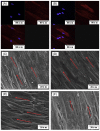Bioceramics/Electrospun Polymeric Nanofibrous and Carbon Nanofibrous Scaffolds for Bone Tissue Engineering Applications
- PMID: 37049093
- PMCID: PMC10095723
- DOI: 10.3390/ma16072799
Bioceramics/Electrospun Polymeric Nanofibrous and Carbon Nanofibrous Scaffolds for Bone Tissue Engineering Applications
Abstract
Bone tissue engineering integrates biomaterials, cells, and bioactive agents to propose sophisticated treatment options over conventional choices. Scaffolds have central roles in this scenario, and precisely designed and fabricated structures with the highest similarity to bone tissue have shown promising outcomes. On the other hand, using nanotechnology and nanomaterials as the enabling options confers fascinating properties to the scaffolds, such as precisely tailoring the physicochemical features and better interactions with cells and surrounding tissues. Among different nanomaterials, polymeric nanofibers and carbon nanofibers have attracted significant attention due to their similarity to bone extracellular matrix (ECM) and high surface-to-volume ratio. Moreover, bone ECM is a biocomposite of collagen fibers and hydroxyapatite crystals; accordingly, researchers have tried to mimic this biocomposite using the mineralization of various polymeric and carbon nanofibers and have shown that the mineralized nanofibers are promising structures to augment the bone healing process in the tissue engineering scenario. In this paper, we reviewed the bone structure, bone defects/fracture healing process, and various structures/cells/growth factors applicable to bone tissue engineering applications. Then, we highlighted the mineralized polymeric and carbon nanofibers and their fabrication methods.
Keywords: bone tissue engineering; electrospinning; mineralization; nanofibers.
Conflict of interest statement
The authors declare no conflict of interest.
Figures








Similar articles
-
Current progress in application of polymeric nanofibers to tissue engineering.Nano Converg. 2019 Nov 8;6(1):36. doi: 10.1186/s40580-019-0209-y. Nano Converg. 2019. PMID: 31701255 Free PMC article. Review.
-
Development of biomimetic electrospun polymeric biomaterials for bone tissue engineering. A review.J Biomater Sci Polym Ed. 2019 Oct;30(14):1308-1355. doi: 10.1080/09205063.2019.1630699. Epub 2019 Jul 9. J Biomater Sci Polym Ed. 2019. PMID: 31181982 Review.
-
Advancements in electrospinning of polymeric nanofibrous scaffolds for tissue engineering.Tissue Eng Part B Rev. 2014 Aug;20(4):277-93. doi: 10.1089/ten.TEB.2013.0276. Epub 2013 Oct 12. Tissue Eng Part B Rev. 2014. PMID: 24004443 Review.
-
Electrospun nanostructured scaffolds for bone tissue engineering.Acta Biomater. 2009 Oct;5(8):2884-93. doi: 10.1016/j.actbio.2009.05.007. Epub 2009 May 15. Acta Biomater. 2009. PMID: 19447211
-
Hydroxyapatite-intertwined hybrid nanofibres for the mineralization of osteoblasts.J Tissue Eng Regen Med. 2017 Jun;11(6):1853-1864. doi: 10.1002/term.2083. Epub 2015 Sep 10. J Tissue Eng Regen Med. 2017. PMID: 26354141
Cited by
-
Special Issue: Bioceramics, Bioglasses, and Gels for Tissue Engineering.Gels. 2023 Jul 21;9(7):586. doi: 10.3390/gels9070586. Gels. 2023. PMID: 37504465 Free PMC article.
-
Research advances of nanomaterials for the acceleration of fracture healing.Bioact Mater. 2023 Aug 27;31:368-394. doi: 10.1016/j.bioactmat.2023.08.016. eCollection 2024 Jan. Bioact Mater. 2023. PMID: 37663621 Free PMC article. Review.
-
Effectiveness of the Association of Fibrin Scaffolds, Nanohydroxyapatite, and Photobiomodulation with Simultaneous Low-Level Red and Infrared Lasers in Bone Repair.Materials (Basel). 2024 Sep 3;17(17):4351. doi: 10.3390/ma17174351. Materials (Basel). 2024. PMID: 39274741 Free PMC article.
-
An Overview on the Big Players in Bone Tissue Engineering: Biomaterials, Scaffolds and Cells.Int J Mol Sci. 2024 Mar 29;25(7):3836. doi: 10.3390/ijms25073836. Int J Mol Sci. 2024. PMID: 38612646 Free PMC article. Review.
References
-
- Koons G.L., Diba M., Mikos A.G. Materials design for bone-tissue engineering. Nat. Rev. Mater. 2020;5:584–603. doi: 10.1038/s41578-020-0204-2. - DOI
-
- Nekounam H., Gholizadeh S., Allahyari Z., Samadian H., Nazeri N., Shokrgozar M.A., Faridi-Majidi R. Electroconductive Scaffolds for Tissue Regeneration: Current opportunities, pitfalls, and potential solutions. Mater. Res. Bull. 2021;134:111083. doi: 10.1016/j.materresbull.2020.111083. - DOI
-
- Nazarnezhada S., Abbaszadeh-Goudarzi G., Samadian H., Khaksari M., Ghatar J.M., Khastar H., Rezaei N., Mousavi S.R., Shirian S., Salehi M. Alginate hydrogel containing hydrogen sulfide as the functional wound dressing material: In vitro and in vivo study. Int. J. Biol. Macromol. 2020;164:3323–3331. doi: 10.1016/j.ijbiomac.2020.08.233. - DOI - PubMed
Publication types
LinkOut - more resources
Full Text Sources

